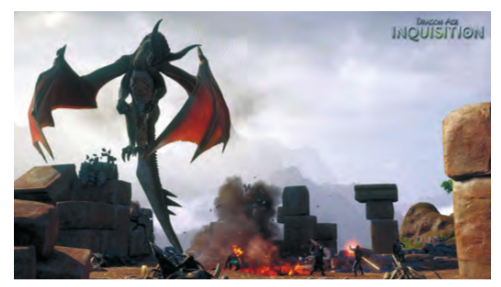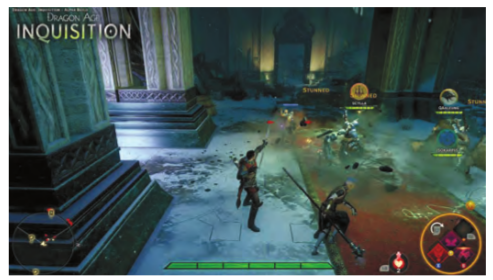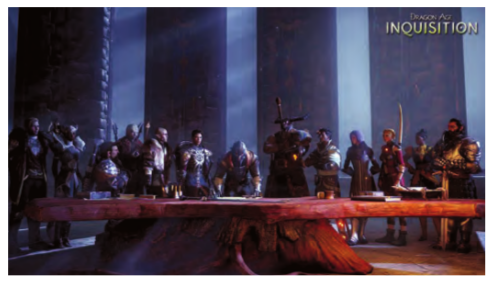 This is not an article about gamification. Unless your website is devoted to dragons, adding quests and hit points won’t improve your users’ engagement with your content. (If your website is devoted to dragons, well that’s just awesome.)
This is not an article about gamification. Unless your website is devoted to dragons, adding quests and hit points won’t improve your users’ engagement with your content. (If your website is devoted to dragons, well that’s just awesome.)
Content – be it text, images, video, data, or a combination of mediums – is the reason we build websites in the first place. It’s right there in the acronym: CMS. Drupal is a system – or more accurately, a framework – for managing content. We strongly believe that all website features, layout, and design choices must support the goal of serving your target audiences with the critical information – the content – they need to engage meaningfully with your organization.
Your content is the connection between your organizational goals and your audiences’ motivations. There’s usually a reason a piece of content is added to a website; somebody, at some point, thought it would be useful. Unless that content has meaning to your users, however, it has little value to your organization. Without a strategy guiding the creation and governance of that content, your quest, noble though it may be, is almost doomed to fail.
Fortunately, it’s not hard to start creating a strategy. We believe you can learn the foundations of content strategy for Drupal websites by breaking down what the team at BioWare did in creating Dragon Age: Inquisition.
Goals and Audiences
You have to start with goals.
BioWare’s basic goal is easy to suss out: they want to make money. To support such a massive undertaking – creating Inquisition involved programmers, writers, producers, graphic artists, vocal talent, project management, and more – the end result had to be a game that would appeal to enough people not only to pay for expenses, but to turn a profit. (We have a strong suspicion the team also wanted to turn around the negative reception Dragon Age 2 met by releasing something that would blow more than a few minds.)
There are also goals built into the game itself. When you play Inquisition, you interact with at least 100 hours of staged content in pursuit of an overall quest – not to mention the scores of side missions you can distract yourself with within the game’s world. Players become more and more invested in the game as their characters become part of the ultimate outcome of the story.
So, before you start building a website, you should define those two things for yourself:
- What are your organization’s goals?
- How can your website, and the content you populate it with, support those goals (by captivating and delighting your audiences)?
But who are those audiences? To create meaningful content, you need to understand who’s going to engage with it. Inquisition takes the concept of “persona” quite literally: players can customize their avatars not simply by selecting a gender, but by adding layers of tattoos, facial hair, outfits, and more.
More important, the designers recognized that different audiences will have different preferences when it comes to gameplay. Inquisition features two entirely different (but complementary) battle systems. If you want to charge right in with your longsword and the Cheese Wedge of Destiny (FYI, that’s an actual shield in the game), you’re free to wade in and hack away. At the click of a button, however, you can switch to the tactical view, stopping time to allow armchair generals to deploy their troops methodically.
In building a website, this difference might manifest itself between users who prefer to enter through your site’s home page and navigate to the content they seek, and those who enter deep within your site because a friend posted a link on Facebook.
By understanding your audiences’ motivations, you’ll be able to better craft content (and the connections between content) to serve their needs and move them toward deeper engagement.
Content Structure
 While the technical aspect of content strategy is often overlooked, we as site builders know that a solid content model defining the structures and boundaries of what can be created is key to success. It’s not a problem unique to websites.
While the technical aspect of content strategy is often overlooked, we as site builders know that a solid content model defining the structures and boundaries of what can be created is key to success. It’s not a problem unique to websites.
Because Inquisition is a role playing game, it features complex systems of character building, crafting, and influence. You increase your team’s abilities not just by slaying enemies and completing quests, but by learning how to make new things – usually of the shiny, sharp, or exploding variety.
For example, to create a “Mighty Offense Tonic” that will provide a damage bonus against a barrier, you need to collect, and then combine, 11 Embrium, 11 Deep Mushroom, and 2 Rashvine Nettle. Oh, and only a Warrior-class character can use it. According to one of the many Inquisition wikis, there are at least 15 potion types, each with multiple variations. Then there are the weapons, the armor, and on and on.
The amount of planning that went into the foundational structure of the game is astounding. It mostly fades into the background when you play, becoming something that you simply do.
The same has to be true for the content on your website. By and large, people don’t come to a website to admire its functionality. In fact, if they notice the structural underpinnings of your content, you’re likely doing it wrong.
Drupal provides all the tools you need to implement a rock-solid foundation. Because any entity can be fielded, careful planning and the creation of models will help you create the structures necessary to support all your content needs.
The key to content modeling is careful planning before you write a single line of code or create a single entity.
If you want to, say, store information about authors separately from blog posts – as you should – your content model should reflect the relationship between the two entities and note that the Author entity requires a display mode that includes only the Author’s name, photo, and shortened bio.
To the end user, the resulting rendered page will be seamless, with the core content enhanced by a brief, visually differentiated blurb about the author – that can be connected to the Author’s full profile and a list of all of her other blog posts; to the content administrator, updating the Author’s image happens in a single place, rather than on every piece s/he has written. This is not the sort of content relationship you want to implement after the writers have copied and pasted bios all over your website.
Content Organization
 Once you’ve defined your structures, you need to map out how they relate to each other.
Once you’ve defined your structures, you need to map out how they relate to each other.
One of the first things you’ll notice about Inquisition is how vast the world is. Want to climb that mountain over there? Go ahead, as long as it’s not too steep; jumping only gets you so far. Interested in the Urthemiel Plateau? It’s all there for you to run around in (and without getting tired).
A small minority of people will likely want to explore every nook and cranny. Others will focus on the tasks at hand.
Triple-A games can’t just rely on great gameplay to make them successful. The story counts for something now, too. Inquisition has over 200 pieces of written history located throughout the world. That’s a lot of content – and it’s not all dumped on you at once.
But if getting from point A to point B is a huge drag and you hate doing it, you’re probably not going to stick around for long. Inquisition recognizes that different audience types may want different things and it rewards them both. In order to succeed, you don’t have to read all of the in-game content if you don’t want to (but you should want to). When you get tired of running around, you can use the fast travel functionality to move between major areas of the world.
Information architecture and content strategy bleed into each other. If users can’t find the content they want on your website, if the paths that benefit your organization are not well defined (and tracked and measured), then the best-written copy in the history of copy won’t help you.
Your actual content needs to remain central to the user’s experience of it. We generally recommend streamlining the information around it. How many sites have you seen that place blocks of links to other content, pop-up modal dialogues, and other distractions in your way, essentially trying to direct you away from the very reason you visited the site in the first place? Some visitors may very well want to explore your entire world, but most of them likely want a minimum of fuss as they travel toward their destinations.
As you plan your content structures, you need to keep in mind the navigational elements, the related content blocks, the search filters, and the calls to action that will transform the user’s delight in finding just the right piece of content – you did delight them, right? – into some action useful to your organization. Just try not to overwhelm them.
Is your goal to convince visitors to sign up for an e-mail list? Highlight that call to action, and minimize the secondary conversion opportunities on that page. Just be sure to tie it into your data: if you know that people who read three or more articles are more likely to sign up, then build your system to feature the related content most likely to get them to continue to read until they reach that moment of inspiration when they decide you’re a trusted source of information.
Community
We’re creating content for people; SKYNET is still at least a few years away.
The creators of Inquisition recognized that their content strategy couldn’t end with the game’s release, so they’ve built in multiple ways to tap the increasingly social nature of the Internet.

Within the game, you can invite your friends to hack and slash at your side in a multiplayer mode, and by default, Inquisition records your gameplay: with just a few clicks, you can share that time when you wandered into the Fallow Mire with your network.
There’s also a universe of fan sites and wikis, in addition to the official community hub that collects BioWare’s own social media outreach, featuring contests, game tips, and more. They’ve embraced the knowledge that they can’t control the message around the content they’ve created (we’re looking at you, Tumblr), but are taking every opportunity to shape it.
Content strategy doesn’t stop at your website. As browsing habits shift, and more and more traffic to our sites comes from search and social media sharing (particularly with the younger generations), we need to recognize that simply creating great content isn’t enough. With so much content being generated – some estimate that 90% of the data humans have ever created was generated over the past two years – the Field of Dreams tactic won’t work.
Your content strategy needs to include active outreach and engagement, through social channels, e-mail, maybe even print. Help people find your great content, remind them that you have great content, and give them the opportunities they need to engage with it.
Conclusion
There are whole swaths of content strategy we haven’t covered here, but like even the most awesome multi-classed character, Drupal can’t do everything. Creating good content and managing the people responsible for it are things we can help with, provide tools for, and perhaps measure, but human systems require their own tactics.
The key is simple: plan. Put purpose behind the reason you’re building websites in the first place. As cool as it might be to create a Rule that populates a related content block based on a user’s referral path, if anyone (who’s not a developer) notices the scaffolding, you’ve probably already lost them.
Define your goals. Understand your audiences. Build the structures that allow content to connect the two. Once you come up with the plan, content strategy is nothing to be afraid of.
But if you know how to make dragon battles not absolutely terrifying, be sure to drop us a line.
Migration
With Drupal 8’s release, we’ll soon be involved in a spate of upgrades – and content migrations. Since Inquisition is third in a connected story, BioWare faced a similar challenge in getting new players up to speed.
DA and DA2 had a metric ton of content, but folks new to the series didn’t want to have to play hundreds of hours of those games to be able to understand Dragon Age: Inquisition. So, the game-makers created a web application allowing players to review all the vital decisions of previous games in a highly-visual, interactive storyboard. Once players selected their actions, they could save the “world state” and import that into their new game of Inquisition, making it seem as though they’d played the previous games, when in fact, they’d basically gone through a checklist.
Sounds nice, right? As part of your content governance and migration strategy, you need to convince your stakeholders they likely don’t need absolutely everything to be moved from an old site to the new. Prioritize your content: bring over only the highest performing and most important pieces and convince your team they should rewrite – or simply kill – the rest.
